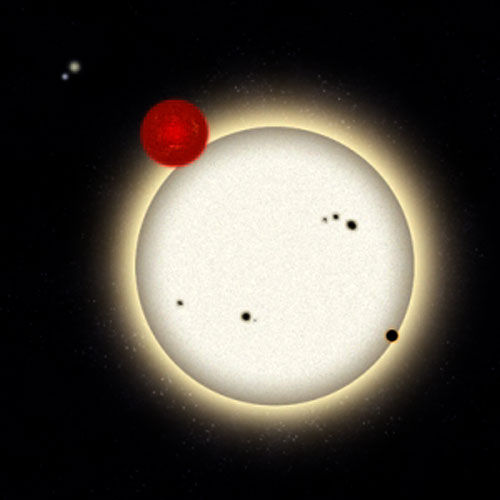-

SYDNEY: A planet whose skies are lit up by four suns – the first reported case of such a phenomenon – has been discovered by an international team of amateur and professional astronomers.
The planet, located about 5,000 light years from Earth, has been dubbed PH1 in honour of Planet Hunters, a program led by Yale University in the United States that enlists volunteers to look for signs of new planets.
PH1 is orbiting two suns and, in turn, is orbited by a second distant pair of stars. Only six planets have been found to orbit a binary system of two stars, researchers say, and distant stars do not orbit these systems.
“Back to the drawing board”
Binary star systems, in which two stars orbit each other, create a stressful environment in which planet formation was once thought impossible. The existence of PH1 in a quadruple star system changes the understanding of formation possibilities in stellar and multistellar systems, the report said.
"Circumbinary planets [planets that orbit two stars] are the extremes of planet formation," said Yale's Meg Schwamb, lead author of a paper presented at the annual meeting of the Division for Planetary Sciences of the American Astronomical Society in Nevada.
"The discovery of these systems is forcing us to go back to the drawing board to understand how such planets can assemble and evolve in these dynamically challenging environments."
The planetary system
PH1 is a gas giant with a radius about 6.2 times that of Earth, making it slightly bigger than Neptune. It orbits a pair of eclipsing stars that are 1.5 and 0.41 times the mass of the Sun roughly every 138 days.
The two other stars are orbiting the planetary system at a distance that is roughly 1,000 times the distance between Earth and the Sun.
The report estimated the age of the planetary system at two billion years; this endurance suggests there has been little interaction between the two binary stars, as any close encounter would obliterate any chance of planets forming.
Because of the extreme conditions within the binary star system, it is believed PH1 formed at a distance from its parent stars and moved inward to its current orbit.
Planet Hunters’ first confirmed planet discovery
Citizen scientists and Planet Hunters participants Kian Jek and Robert Gagliano in the U.S. were the first to identify PH1; their observations were confirmed by a team of U.S. and British researchers working in Hawaii.
Because PH1 is not large enough to produce a measurable eclipse, the observation was possible by examining light curves from the parent binary star, this signifies Planet Hunters’ first confirmed planet discovery.
"It still continues to astonish me how we can detect, let alone glean so much information, about another planet thousands of light-years away just by studying the light from its parent star," Jek said.
The Planethunters.org website was created in 2010 to encourage amateur astronomers to identify planets outside our solar system, using data from the US space agency NASA's Kepler space telescope.
"Just when you think you've seen it all"
"This is a spectacular example of the amazing diversity of planetary systems in the Universe," said Simon O'Toole from the Australian Astronomical Observatory, who was not involved with the research. "Just when you think you've seen it all, along comes a result like this!"
"Four stars, but there's still room for a planet! And the fact that it was discovered by non-astronomers makes it even more special," he said, adding: "The power of citizen science!"
Quelle: Cosmos
4913 Views

